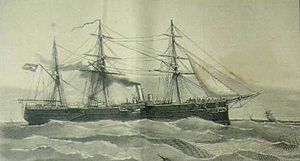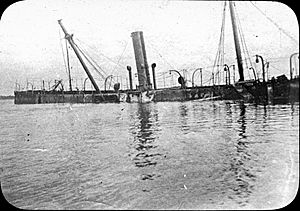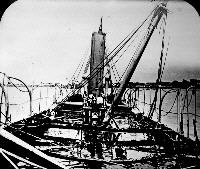Spanish cruiser Velasco facts for kids

Velasco
|
|
Quick facts for kids History |
|
|---|---|
| Name | Velasco |
| Namesake | Velasco |
| Builder | Thames Ironworks & Shipbuilding & Engineering Co. Ltd. |
| Launched | 1881 |
| Fate | Sunk 1 May 1898 |
| General characteristics | |
| Class and type | Velasco-class unprotected cruiser |
| Displacement | 1,152 tons |
| Length | 210 ft 0 in (64.01 m) |
| Beam | 32 ft 0 in (9.75 m) |
| Draft | 13 ft 8 in (4.17 m) maximum |
| Installed power | 1,500 ihp (1,100 kW) |
| Propulsion | 1-shaft, horizontal compound, 4-cylinder boilers |
| Sail plan | Barque-rigged |
| Speed | 13 knots (24 km/h; 15 mph) |
| Complement | 173 officers and enlisted |
| Armament |
|
| Notes | 200 to 220 tons of coal (normal) |
The Velasco was a special kind of warship called an unprotected cruiser that belonged to the Spanish Navy. It was known for its role in the Battle of Manila Bay during the Spanish–American War.
Contents
Building the Velasco
The Velasco was built in the United Kingdom by a company called Thames Ironworks & Shipbuilding & Engineering Co. Ltd. in London. Its construction began in 1881.
Ship Design and Features
Velasco was the first ship in a group of eight similar Spanish cruisers. It had a strong iron body and one tall smokestack. It also had sails, like a barque, which helped it move.
Velasco and another ship from its group, the Gravina, were built in the UK. They had different weapons and were a bit faster than the other six ships in their group, which were built in Spain.
Velasco's Time at Sea
The Velasco had an interesting history of missions and battles.
Patrols and Duties
In 1891, the Velasco was sent to patrol the northern part of Luzon and the nearby Babuyan Islands. Its job was to keep an eye on Japanese merchant ships and make sure everything was peaceful.
The Battle of Manila Bay
When the Spanish–American War started in April 1898, the Velasco was anchored in Manila Bay. It was part of the Spanish fleet led by Rear Admiral Patricio Montojo y Pasaron.
On May 1, 1898, the U.S. Navy's Asiatic Squadron attacked the Spanish ships. The Velasco was still anchored because its engines were being fixed on land. All its main guns had been moved to a nearby island for defense. Even though it couldn't fight, the Velasco was sunk during the battle.
See also
 In Spanish: Velasco (1881) para niños
In Spanish: Velasco (1881) para niños



